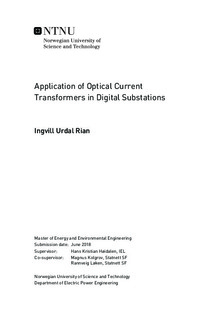| dc.description.abstract | In this master's thesis optical current transformers are studied in order to evaluate whether such sensors are suitable for application in digital transmission substations. The analysis includes a discussion of benefits and drawbacks and an evaluation of performance, maturity and fulfillment of substation application requirements as well as the digital substation concept. Experimental testing of a stand-alone merging unit is also performed with the objective of investigating its performance and comparing it to the performance of a conventional analog acquisition system. Potential impacts on the performance of transformer differential protection is also investigated.
The laboratory tests show that the stand-alone merging unit has a steady state performance which is comparable to that of a conventional analog acquisition system and a significantly better transient performance.
As a result of the differing transient performances, fundamental frequency differential currents arise when these two technologies are combined in a hybrid mode configuration of a transformer differential protection. The resulting fundamental frequency differential currents are not big enough to affect the performance of the transformer differential protection in the tested cases.
Optical current transformers offer many benefits compared to conventional current transformers. Some of these are improved safety, reduced environmental impact, reduced need for maintenance and improvements in steady state and transient performance. The low weight facilitates integration with other primary equipment, which allows space to be saved in the substation yard. The combination of optical current transformers and a process bus makes the design of digital substations flexible and facilitates cost reductions.
The standards which apply to non-conventional instrument transformers and digital substations often leave some room for interpretation. This may lead to lack of interoperability between devices from different vendors in a digital substation. Competence building will also be required, and digital substations may be expected to become more vulnerable than the present day conventional substations due to outdoor placement of electronics and stringent time synchronization requirements.
It is concluded that optical current transformers seems to be suitable for application in digital transmission substations. However, there are several signs that the products and solutions are not completely mature yet. There are several investigations to be made, questions to be answered and issues to be solved before a migration from the present day conventional substations with conventional current transformers to digital substations with optical current transformers can take place. | |

